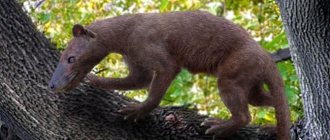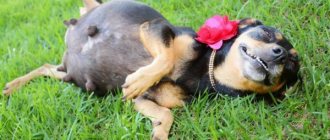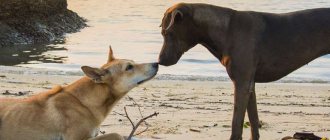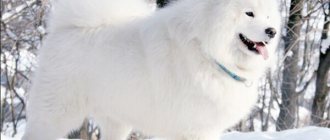Evolutionary theory
A dog is a carnivorous mammal of the canine family. According to evolutionary theory, in the first era of the Paleogene period - the Paleocene (about 50 million years ago) there already existed a group of carnivores, which, in turn, was divided into two suborders: felids and canids. One of the first representatives of the second suborder is considered to be such an animal as Progesperocion. Having carefully studied his fossil remains, we can conclude that he looked like a dog: wide mouth, sharp fangs, high paws, long body. Over time, this suborder divided into three more groups.
The first group included representatives of the descendants of Progesperocyon, the second - the borophagous family, and the third - wolves. It is the latter family and the origin of dogs that are closely related, because, according to evolutionary theory, our four-legged friends descended from wolves.
A Brief History of the Dog's Origin
Previously, there were many versions of the origin of dogs from the jackal, coyote and wolf. They thought that some might come from jackals, others from wolves and coyotes, hence the diversity of breeds. But science does not stand still; over the past 5 years, scientists have learned exactly who the dog actually comes from? Experts conducted a genetic analysis and found that the direct ancestor of dogs was an ancient wolf. From it there are 2 branches: the genus of dogs and wolves.
This is proven by the fact that both the wolf and the dog have 78 chromosomes. The jackal has a completely different set and cannot be the ancestor of modern dogs. Experts believe that that ancient wolf-like ancestor is already extinct. Previously, it was widespread in Africa, Asia and Europe. There is an assumption that even in North America. People brought dogs to other continents later.
Dogs have changed since they were domesticated. They became different in appearance, the changes affected their behavior. Our pets now have both straight and hanging ears, they can wag their tail and it is often located above the back and in a ring. Pets bark, which is something wolves cannot do so much. The wolf can only bark a few times; he cannot bark. The dogs became loyal and became very attached to their owner and family members. They obey, loving him. They can be trained.
Charles Darwin's assumptions
Charles Darwin's expeditions on the Beagle ship allowed him to travel to different countries. He, like no one else, studied the origin of dogs and tried to find out the truth. Charles Darwin established an interesting pattern, which was that dog breeds in certain territories are very similar in their external characteristics to the representatives of the genus Wolves living there. So, for example, in one region the domestic dog was very similar to the foxes living there, and in another - to the jackals. In various territories there actually lived breeds of dogs similar to local predators.
Thus, some scientists believe that the origin of dogs is due to the fact that, as part of uncontrolled reproduction, the crossing of various animals took place: foxes, wolves, jackals, coyotes (since each representative has 39 pairs of chromosomes, they can actually have a hybrid generation). As a result, each breed had common features of similarity with one or another species, but at the same time was significantly different from it. Indeed, some breeds are very similar to foxes, and some to jackals. And if we add selection and artificial selection to this, then perhaps the origin of dog breeds is connected precisely with the crossing of animals of the same family.
Marquis&Ko
The domestic dog belongs to the carnivorous order of mammals. The question of the origin of the domestic dog still remains an intractable problem. The challenge is that domestic dogs are a surprisingly diverse and widely variable group. In terms of the scope of morphological variability, the dog, which scientists consider to be a single species, can be compared with the entire canine family, represented by more than three dozen species. Moreover, many wild species of the canine family correspond in general terms to breeds of domestic dogs that are similar in appearance to them.
Common or gray wolf (Canis lupus)
The overwhelming majority of authors name species of the genus Canis as possible ancestors of the domestic dog, and most often the wolf is considered the ancestor of the dog, and less often the common jackal. Other species of this genus appear as possible progenitors of the dog by a smaller number of authors.
Modern remains of dogs found during excavations of Stone Age human sites indicate that the ancestors of domestic dogs lived close to the settlements of primitive man and ate garbage. This contributed to the gradual domestication of the dog.
The domestication of the ancestors of the modern domestic dog occurred in different places, as a result of which the animals were characterized by significant diversity. All this allowed man to create breeds of domestic dogs with different behaviors and external forms.
Dog: clay sculpture, Eastern Han, 25-220 AD.
The dog is the first animal tamed and domesticated by man. Judging by archaeological excavations, this happened in the Stone Age, when ancient people were not yet engaged in agriculture and cattle breeding, but obtained food and clothing by hunting wild animals. In Europe, the oldest finds of domestic dog bones were made in the so-called “Danish kitchen” and in the Swedish Neolithic sites at Sjöhalmen. The age of their inhabitants is 10-12 thousand years. Dog remains have been found in England dating back to 7200-7900. BC. The remains of dogs approximately 11.5 thousand years old were discovered in Iran. Almost the same antiquity (9.5-8.3 thousand years BC) bone remains were found in Beverhead Cave in Idaho.
In 1862, the remains of a dog dating back to the Neolithic period (about 10 thousand years BC) were found in pile buildings of Swiss lakes. They belonged to a small dog, which was called peat (or marsh). Later, the remains of a similar dog were found during excavations near Munich, in Pomerania, in caves in Belgium near Mainz, in Egyptian tombs, and in Russia - on the coast of Lake Ladoga, in the Vladimir province. Some of the dogs were very tall.
As the living conditions of ancient man changed and improved, especially with the transition to a sedentary lifestyle, farming and cattle breeding, the requirements for the dog expanded and increased. This prompted man to develop new specialized breeds. An artificial selection of dogs with qualities useful to him was carried out. Other methods of improving dogs were also used. For example, according to the ancient Roman writer and scientist Pliny, the Gauls tied their female dogs in the forests to mate with wolves, so that their unpretentiousness, high endurance and ferocity would be passed on to the descendant puppies. With the active influence of man and purposeful breeding activity in various parts of the globe, dog breeds were developed and became widespread, adapted for hunting, guarding homes and domestic animals, transporting heavy loads, military purposes, etc.
The results of centuries-old breeding work are well tracked by images of dogs on ancient monuments. On Egyptian monuments 3400-2100. BC. Dogs of various breeds are depicted. Most of them look like greyhounds. Later monuments of this period depict dogs similar to hounds and dachshunds. And on an Assyrian monument dating back to around 640 BC, there is an image of a large mastiff. There are enough similar examples to confirm that different breeds of dogs existed several thousand years ago.
Konrad Lorenz believes that man first attracted the jackal to let him know about the approach of large predators and other enemies. Then the dogs began to help in the hunt. A different picture emerges if we assume that the dog’s ancestor was first used specifically for hunting. Obviously, wolves or other animals stronger than the jackal were more suitable for this. One way or another, the “prodog” had to be an animal with highly pronounced socialization, i.e. the ability to get used to and become attached to other beings, including people. Therefore, it almost certainly must be a pack animal. Of the dog's living relatives, the wolf is the most social, although both jackals and coyotes have well-developed these qualities.
Common or Asian jackal (Canis aureus)
A necessary condition for the domestication process was selection for loyalty and non-aggression towards humans. Many authors call selection for reduced aggressiveness towards humans the most important factor.
In the book by K. Lorenz “A Man Finds a Friend” you can read that all dogs descended from two ancestors - the wolf and the jackal. Lorenz believes that all dog breeds are divided into “wolf” and “jackal”. When deciding what type a particular breed belongs to, he primarily focuses on the behavior of the dog.
There is a point of view that modern domestic dogs are a polyphyletic group , descended from several ancestors ( monophyletic - from one ancestor). One of the first to express this point of view was the French naturalist Saint-Hilaire . The great Englishman Charles Darwin was also inclined towards it. A prominent specialist in domestic animals, the German professor of zoology, the German Keller, . In favor of the polyphelic origin of dogs, Keller gave the following considerations:
- domestic dogs, in which the characteristics of the breed are clearly expressed from the very beginning, appear early in cultural areas far apart from each other;
- dogs living in different areas have similarities with the wild canines that live there - an argument taken from Darwin;
- The group of domestic dogs is too diverse and heterogeneous to be explained only by artificial selection made with the descendants of one ancestor.
Indeed, no domestic animal has such a wide range of breeds as dissimilar from each other as the domestic dog.
Keller identifies the following main groups of domestic dogs and their ancestors:
- Spitz-shaped;
- pariah dogs;
- shepherd dogs;
- greyhounds and hounds bred from them;
- mastiff dogs;
- dogs of the new world before Europeans arrived there.
Ethiopian jackal (Canis simensis)
Keller names the common jackal . The same species gave rise to the Asian pariah dogs, while the African pariah dogs are bred from the African jackal-wolf, which is now considered a subspecies of the common jackal. The group of shepherd dogs, according to Keller, descends from the Indian wolf, which at the beginning of the twentieth century was considered an independent species, and is now classified as a small subspecies of the gray wolf. The center of origin of greyhounds, a very ancient group, is located in Ancient Egypt. Greyhounds have been mentioned since the Old Kingdom, when they were used to hunt antelope. Keller calls the Ethiopian jackal , a slender, long-legged and very long-faced medium-sized animal, the progenitor of the group of greyhounds. Keller also mentions that the Egyptians kept tame hyena dogs, excellent hardy runners and hunters of various antelopes. From greyhounds a line can be traced to the typical hound dog. In Ancient Egypt there is an image of an ancient dog that looked like a dachshund, only with erect ears.
In another ancient civilization in the world, the Sumerian-Babylonian, very early evidence of the existence of Great Danes is found. Chronicles mention the existence of Great Danes 4 thousand years BC. Most authors derive all Great Danes from the Tibetan Great Dane, which is believed to have in turn descended from the Tibetan wolf. Currently, the Tibetan wolf is completely extinct; it was an animal similar to an ordinary wolf, only black in color and denser in constitution. The Tibetan Great Dane is a very large dog, “the size of a donkey,” as Marco Polo described it in 1300. The Great Dane was used to hunt wild bulls.
K.T. Sulimov , who was involved in the hybridization of the jackal and the dog, that the common jackal can hardly be the main ancestor of the dog: these species are too different in their expressive movements and general pattern of behavior. And wolves and dogs easily find the necessary mutual understanding. Wolves and dogs mate not only in artificial conditions, but also in nature, when the she-wolf or wolf does not have a partner among their tribe.
Coyote (Canis latrans)
But the modern canine fauna is a poor and pitiful likeness of the rich and abundant one that was on Earth during the late Pleistocene, when the process of domestication of dogs began. And K.T. Sulimov believes that one of the dog’s ancestors could have been an extinct species similar to a coyote. Cases of hybridization between a coyote (meadow wolf) and a dog are known even in nature.
In recent years, the solution to the question of the origin of dogs has made significant progress. Based on the achievements of modern science, especially genetics, many scientists believe that, despite all the diversity of dogs, they descended from one wolf-like ancestor, from which, through divergence and divergence of branches, dogs arose on one side, and wolves in their present form on the other. .
This is confirmed by the number of chromosomes present in the same quantity - 78, both in dogs and in wolves. The jackal has a different chromosome set and the dog could not have descended from it. Apparently, the extinct wolf-like ancestor of the dog and wolf was widespread throughout the globe, and from it local dogs originated, namely in Europe, Asia, northern Africa, and possibly North America. Dogs were brought to other continents later.
As a result of domestication, dogs experienced significant changes in the structure and functions of the body, their appearance and behavior changed. Domestic dogs now have drooping ears, a curved tail, and the ability to bark and wag their tail. They also acquired new character traits: attachment to humans, devotion to the owner, obedience, and the ability to train.
- Encyclopedia of Dog Breeding, Composition. V. Zubko, A. Alekseev. – M.: TERRA – Book Club, 1998. – 544 p.: ill.+16 with.incl.
Dog phenotype and dog breeding
As we have already found out, the history of the origin of dogs has not been fully studied. It is difficult to say with absolute certainty who they came from. But even greater interest lies in artificial selection and selection. There are about four hundred different dog breeds. They differ in height, weight, color, shape of ears and tail, and many other markers of domestication.
The type of activity whose main goal is to breed and improve dog breeds is called dog breeding. Selective selection is primarily based on the purpose of breeding a particular breed of dog. There are three directions: decorative, hunting and service. For each there are certain requirements: weight, height, head, muzzle, nose, etc.
History of the origin of the dog
Entering onto the shaky ground of theories and conjectures based on scant evidence and fragmentary findings, we will immediately disappoint those for whom only facts are important: there are very few of them so far. Even the origin of the word dog remains unclear - either from the Scythian “spaka”, or from the ancient Parsi “sabah”, or from the Slavic “from the side”, that is, from the side. Who were the ancestors of dogs? How and who domesticated whom? For what purpose? One version is more curious than the other, and all of them are partially confirmed by archaeologists and geneticists.
About 50 million years ago, the planet was inhabited by miacids, from which all known predatory mammals presumably originated. These were small animals, somewhat similar to martens: an elongated flexible body, a long tail, sharp teeth, and most importantly, a large brain, which indicates a high level of intelligence. And only 35 million years later, the descendants of miacids acquired features similar to modern dogs (as well as foxes, bears, etc.).
NO MUCH WOLF YOU FEED...
Just a couple of decades ago, the theory of the origin of a dog from a wolf was considered the most likely. Scientists trying to refute it were not taken seriously. How else? Wolves and some ancient, “primitive” breeds of dogs are very similar both in appearance and in the social structure of the pack. Genetically, they are almost a copy of each other. Dogs and wolves are capable of producing common offspring, and sometimes mate in natural conditions, without human intervention.
But recent archaeological finds and scientific experiments almost completely deny the “wolf” origin of dogs. Why? Bend your fingers:
*
Numerous attempts to create a new species by crossing a dog and a wolf have failed. Hybrids (up to the 16th generation) remain hybrids - hysterical, antisocial, passive-aggressive;
*
The skulls of ancient dogs are strikingly different from the skulls of an ancient wolf, when logically they should be even more similar than today;
*
To this day, the wolf cannot be domesticated. To tame, having certain knowledge, yes, but to domesticate is impossible. If the dog descended from even wilder, ancient wolves, how did people manage to become such close friends with these animals in such a short period (compared to the history of the planet)?;
*
If the origin of the dog from the wolf were indeed true, why are modern dogs inferior to wolves physiologically? A person, by domesticating any animal, makes it better, this is beneficial. Domestic chickens lay eggs better than wild ones, cows give more milk, horses are more resilient than their wild ancestors. In the process of domestication, primitive selection occurs, the selection of the best producers, which certainly leads to the fact that the domesticated animal becomes better, bigger, stronger, meatier (from whom what is required). And a dog, under equal conditions (weight, build, degree of aggression, etc.) is inferior to a wolf;
*
And finally, it was recently discovered that the dog is genetically closer to the coyote than to the wolf. By the way, it is coyotes and jackals that can approach a village in a “hunger year” and hang around nearby, clearly begging for a handout or stealing waste. According to one theory (not indisputable), this is how the ancestors of dogs behaved. But the wolf will not look for garbage. Rather, the flock will attack people, considering them easy prey.
Previously, it was believed that the history of the origin of the dog goes back to a single species from which all modern breeds originated. This theory spoke in favor of a “wolf” past. However, many scientists are now inclined to believe that dogs, despite such a similar genotype, descend from several prehistoric species.
*
In different areas, fragments of skeletons of prehistoric dogs are found, which belong to approximately the same period, but differ greatly in size, structure and other parameters;
*
The DNA of northern sled dogs is very similar to that of dingoes, which sets them apart from all other breeds. And these are at least two ancestors. And, by the way, there are less similarities with polar wolves than with dingoes. Why? Did you bring your dogs with you? Why didn’t the northerners domesticate local wolves?;
*
While studying the origin of dog breeds, zoologists conducted numerous studies on interbreeding. The result was surprising: all mestizos are very similar to each other, the external difference is erased. This means that having monotonous material (a single ancestor), people would not be able to develop so many breeds. Eventually, the dogs would begin to resemble each other, differing only in size and coat color, the difference would disappear.
Interesting information
The smallest dog breed is, of course, the Chihuahua. One of its representatives, Boo-Boo, weighs 600 grams and is 10 centimeters tall. The Chuhuahua is a sweet companion animal. They are very shy, curious and observant. But the largest dog (Great Dane breed) - Zeus, has a height of 110 cm and a weight of about 70 kg. This giant dog breed is very kind and playful, but only towards its owners. Representatives of this species are often trained as bodyguards.
The origin of the word “dog” is also covered in many secrets and mysteries. It appeared in Russian in the 12th century. There are a huge number of versions about the origin of this word. Some believe that it comes from the Turkic “kobyak”, which translates as “domesticated animal of prey.” Over time, the Slavs turned it into the more easily pronounced "dog". A more scientific version, favored by scholars like Miller and Vasmer, is that the word "dog" comes from the Iranian sabāka, which translates to "fast." Until the 12th century, the animal was called “dog” or “hort”. Moreover, it is interesting that “dog” was used for dogs with thick hair, but “hort”, on the contrary, was used for smooth-haired breeds.











